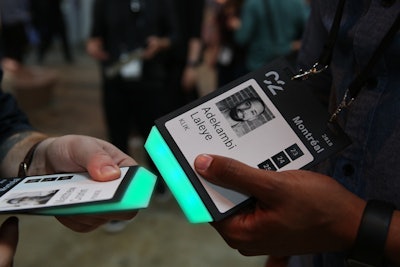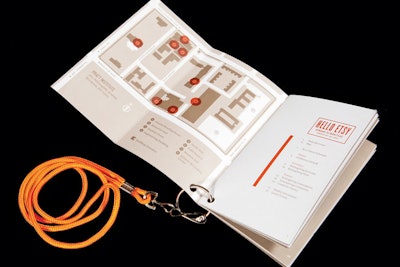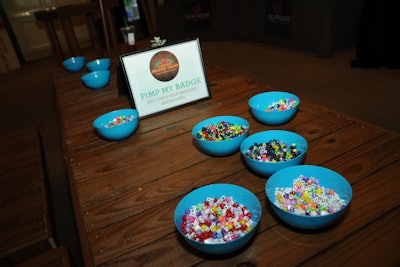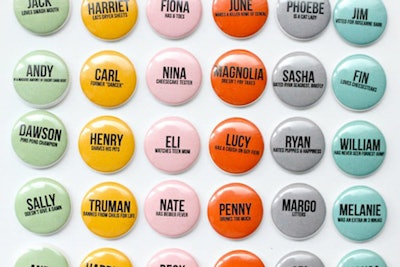
TEDActive in Palm Springs, California, in 2013, had a similar idea: Buttons with blank fields labeled "Talk to Me About ... " invited guests to write a short list of topics they love or are knowledgeable about, to encourage meaningful mingling. Attendees could attach the buttons to their existing badges. The independent TED-style event TEDxWaterloo in Canada, takes it a step further, leaving titles and company names off of name badges. Instead, organizers leave 40 characters on the badges for attendees to finish the phrase “I'm chasing … ,” which gets conversations started among attendees on a deeper level.
Photo: Alesandra Dubin/BizBash
2. Kill two birds with one stone.

Badges are also an opportunity to give attendees necessary information—without making them carry around a heavy event program. At C2 Montréal last month, attendees wore klik name badges from Montreal-based technology company PixMob. In addition to displaying guest credentials in a large, easy-to-read format, the badges connected them to the klik technology—an audience engagement solution that can be used for ticketing and registration, data and analytics, event communication, and much more. The LED wearable can light up in 16-million different colors in response to remote control commands. In addition to badges, the klik technology can be used in wristbands and in buttons on lanyards; event organizers can rent or buy the wearables.
Photo: Mateo Casis

For Etsy’s first New York conference in 2013, organizers demonstrated simple changes to enhance sustainability. The conference program and badge were combined into one item to minimize waste and to keep attendees' hands free.
Photo: The Photo Booth Party

Another way badges can increase effectiveness is through the addition of a Poken. The device attaches to a badge's lanyard and comes in dozens of conversation-starting designs such as a panda bear, a ninja, and a bumblebee (as well as a simple black-and-white model). The device uses near-field communication, so simply tapping two together exchanges the information stored on them, such as contact information, social network profiles, documents, videos, and Web sites. After the event, users plug the Poken into their computer's USB port to see all the people and information collected.
Photo: Courtesy of Poken

Summer Brand Camp—an annual conference in Dallas for foodservice industry professionals working in human resources, marketing, and operations—incorporates camp-style elements every year. For the 2015 conference, organizers evoked a craft station at a kids’ camp, inviting guests to decorate their name badges with colored beads.
Photo: Jill Harper/Summer Brand Camp
4. Sometimes, less is more.

For smaller events, name tags don’t have to break the budget—or stick to a standard format. Artist marketplace Minted suggests a D.I.Y. option for event hosts using a simple button maker. The colorful round buttons are a simple, unobtrusive way to share guest names plus a small fun fact about them—which encourages conversation. Read more about the process on Minted’s Julep blog.
Photo: Melanie Blodgett for Julep



















